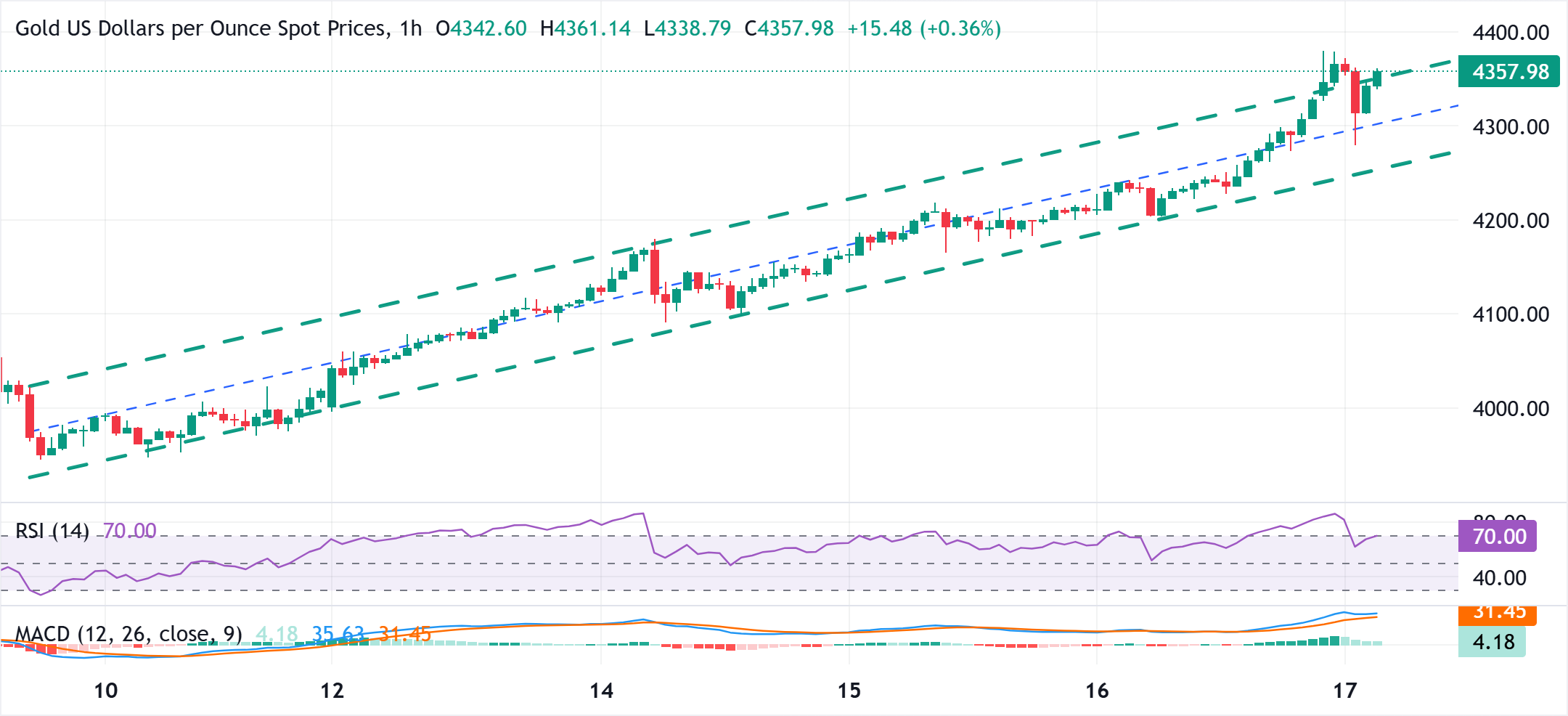Created
: 2025.10.17














![]() 2025.10.17 12:52
2025.10.17 12:52
Gold (XAU/USD) reverses an Asian session dip to the $4,280-4,279 region and climbs back closer to the all-time peak, touched earlier this Friday. The commodity is currently trading just below the $4,350 level, nearly unchanged for the day, and remains on track to register gains for the ninth consecutive week amid a supportive fundamental backdrop. Economic risks stemming from brewing US-China trade tensions and a prolonged US government shutdown continue to drive safe-haven flows towards the precious metal amid geopolitical uncertainties.
Apart from this, the growing acceptance that the US Federal Reserve (Fed) will lower borrowing costs two more times this year has been underpinning demand for the non-yielding Gold. Meanwhile, dovish Fed expectations drag the US Dollar (USD) to an over one-week low, which has further benefited the commodity since the beginning of this week and contributed to the strong move up. The XAU/USD bulls seem affected by overbought conditions on short-term charts. This suggests that the path of least resistance for the bullion remains to the upside.

The daily Relative Strength Index (RSI) remains well above the 70 mark. This might prompt the XAU/USD bulls to take some profits off the table and trigger a sharp retracement slide. That said, any corrective fall below the $4,300 mark might continue to find some support near the Asian session low, around the $4,280-4,279 region. However, some follow-through selling could drag the Gold price towards the $4,235-$4,230 region en route to the overnight trough, around the $4,200 mark. The latter should act as a key pivotal point, which, if broken decisively, should pave the way for deeper losses.
On the flip side, momentum beyond the $4,379-4,380 region, or the Asian session high, could extend towards conquering the $4,400 round figure. A sustained strength beyond the latter will be seen as a fresh trigger for bullish traders and assist the Gold price to prolong its recent well-established uptrend witnessed over the past two months or so.
Gold has played a key role in human's history as it has been widely used as a store of value and medium of exchange. Currently, apart from its shine and usage for jewelry, the precious metal is widely seen as a safe-haven asset, meaning that it is considered a good investment during turbulent times. Gold is also widely seen as a hedge against inflation and against depreciating currencies as it doesn't rely on any specific issuer or government.
Central banks are the biggest Gold holders. In their aim to support their currencies in turbulent times, central banks tend to diversify their reserves and buy Gold to improve the perceived strength of the economy and the currency. High Gold reserves can be a source of trust for a country's solvency. Central banks added 1,136 tonnes of Gold worth around $70 billion to their reserves in 2022, according to data from the World Gold Council. This is the highest yearly purchase since records began. Central banks from emerging economies such as China, India and Turkey are quickly increasing their Gold reserves.
Gold has an inverse correlation with the US Dollar and US Treasuries, which are both major reserve and safe-haven assets. When the Dollar depreciates, Gold tends to rise, enabling investors and central banks to diversify their assets in turbulent times. Gold is also inversely correlated with risk assets. A rally in the stock market tends to weaken Gold price, while sell-offs in riskier markets tend to favor the precious metal.
The price can move due to a wide range of factors. Geopolitical instability or fears of a deep recession can quickly make Gold price escalate due to its safe-haven status. As a yield-less asset, Gold tends to rise with lower interest rates, while higher cost of money usually weighs down on the yellow metal. Still, most moves depend on how the US Dollar (USD) behaves as the asset is priced in dollars (XAU/USD). A strong Dollar tends to keep the price of Gold controlled, whereas a weaker Dollar is likely to push Gold prices up.
![]()
Created
: 2025.10.17
![]()
Last updated
: 2025.10.17

FXStreet is a forex information website, delivering market analysis and news articles 24/7.
It features a number of articles contributed by well-known analysts, in addition to the ones by its editorial team.
Founded in 2000 by Francesc Riverola, a Spanish economist, it has grown to become a world-renowned information website.
We hope you find this article useful. Any comments or suggestions will be greatly appreciated.
We are also looking for writers with extensive experience in forex and crypto to join us.
please contact us at [email protected].
Disclaimer:
All information and content provided on this website is provided for informational purposes only and is not intended to solicit any investment. Although all efforts are made in order to ensure that the information is correct, no guarantee is provided for the accuracy of any content on this website. Any decision made shall be the responsibility of the investor and Myforex does not take any responsibility whatsoever regarding the use of any information provided herein.
The content provided on this website belongs to Myforex and, where stated, the relevant licensors. All rights are reserved by Myforex and the relevant licensors, and no content of this website, whether in full or in part, shall be copied or displayed elsewhere without the explicit written permission of the relevant copyright holder. If you wish to use any part of the content provided on this website, please ensure that you contact Myforex.
Myforex uses cookies to improve the convenience and functionality of this website. This website may include cookies not only by us but also by third parties (advertisers, log analysts, etc.) for the purpose of tracking the activities of users. Cookie policy